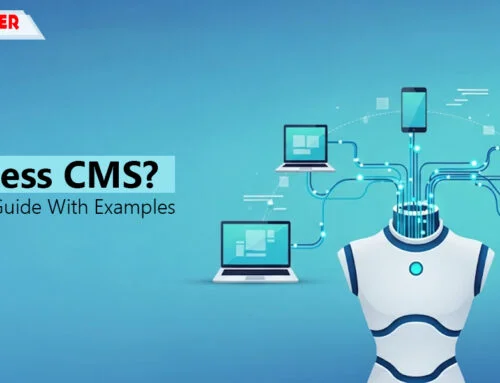Imagine logging onto Amazon and typing, “the best outdoor jacket for hiking in chilly weather under $150.”
And boom…1,495 results appear.
Pages of options, endless reviews, and decision fatigue kick in. Sound familiar?
That’s where you need Amazon Rufus AI – your smart shopping companion that feels less like a search bar and more like a trusted friend who knows every product inside out and recommends exactly what fits your needs.
Here’s everything you need to know about the AI that’s quietly transforming how millions shop, search, and decide. Let’s dive in.
What is Amazon Rufus?
Amazon Rufus is a new generative AI-powered conversational shopping assistant in the Amazon shopping app and website. It is basically a type of chatbot designed to make your shopping experience smarter, faster, and more personal. Think of it as an advanced form of Answer Engine Optimization (AEO) applied within Amazon’s ecosystem.
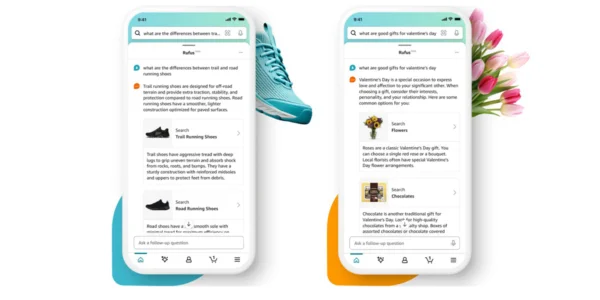
Source – Amazon
The core purpose is to transform the traditional keyword-based search process into a more natural and efficient conversation that helps shoppers research products, get personalized recommendations, and make well-informed purchase decisions. Built using Amazon’s own product data and AI technology, Rufus understands context, intent, and even follow-up questions. It doesn’t just fetch results, it helps you decide.
For instance, instead of typing long keywords or scrolling through endless results, you can simply ask Rufus a question like, “Which shoes are best for running?” or “What’s a good laptop for graphic design under $800?”
Within seconds, it provides you with curated suggestions that include detailed product insights, comparisons, and reviews — all in one interactive chat.
| 💡FUN FACT
🐾 Amazon AI assistant Rufus is named after a Welsh Corgi, one of the earliest office dogs at Amazon! Back in 1996, Rufus roamed the first warehouse, loved joining meetings, and charmed early employees, becoming a symbol of Amazon’s friendly, inclusive culture. |
Now, let us understand how it transforms a simple question into a personalized shopping journey. This is where it gets interesting.
How Does Amazon Rufus Work?
Amazon Rufus AI works like a personal shopping assistant that lives inside your Amazon app. Behind the friendly chat interface lies a powerful stack of generative AI, machine learning, and cloud infrastructure that works together to provide helpful answers to the shoppers.
This technology mirrors how digital advertising and search optimization tools process intent and personalize results.
Let’s break it down step by step:
1. Triggering the Conversation
When you open the Amazon app or website and start typing or speaking your query in the Rufus chat window, Rufus AI understands it as a conversational query instead of just a typical keyword.

From there, the system switches into its “assistant mode,” ready to parse intent, context, and your underlying need.
2. Parsing Your Question: Intent + Context
Rufus does not just look for keywords; it focuses on understanding your meaning (the same principle that drives semantic search optimization in SEO).
This happens in multiple steps:
- Natural Language Understanding (NLU): This breaks down your question into intent, entities, and constraints. For example, in “best noise-cancelling earbuds under $200,” it sees “noise-cancelling,” “earbuds,” and the price cap.
- Context Integration: If you previously asked, “What’s good for running?” & then “What about in rainy weather?”, Rufus carries over that context.
- Reranking & Filtering: It filters out irrelevant items and focuses on the products that match your criteria (brand, budget, features, etc.).
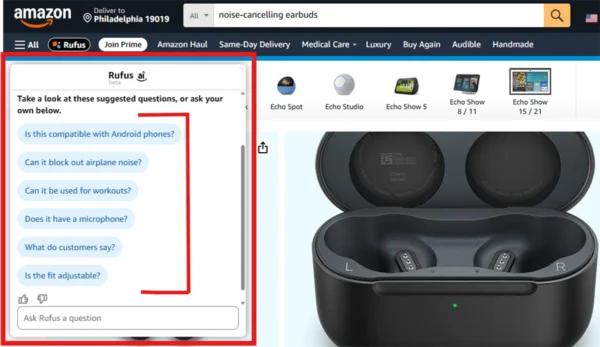
As Rufus is deeply integrated into Amazon, it has direct access to product catalog data, reviews, Q&A threads, and web references.
3. Generating the Answer
Once it understands what you’re asking, Rufus invokes its generative engine model to produce responses and recommendations. It uses combinations of specialized sub-models and a hybrid architecture (for ranking, summarization, context reasoning).
To meet real-time response demands (especially during Prime Day), Rufus predicts multiple future tokens using parallel decoding, which doubles the generation speed. To power this heavy compute, Amazon uses its own purpose-built silicon that cuts inference cost and latency.
| 💡FYI Parallel Decoding – A method where the AI predicts several possible next words or phrases at once instead of one by one. |
In practice, this means your questions are answered almost instantly, even when the backend is navigating thousands of product possibilities.
4. Answering the Question
After the complete research and evaluation, Rufus Amazon AI provides a polished and user-friendly response. That includes:
- A written explanation (why these products, what trade-offs).
- A mini-preview of matching items (images & brief specifications).
- Highlighting pros & cons or summarizing customer sentiments.
- Option to dive deeper (tap “See more,” view full listings, or compare side-by-side).
- Ability to follow up (like “What about waterproof options?” or “Show me more colors.”)
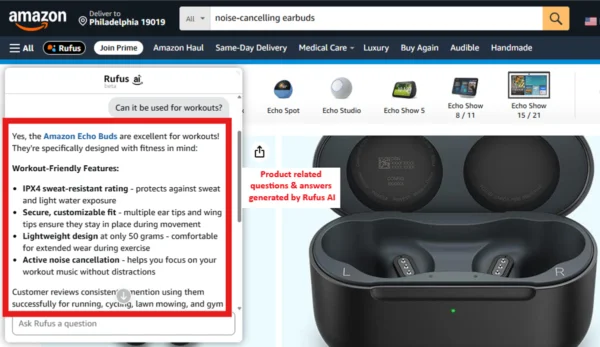
If you are on a product page, AI Rufus can answer questions specific to that item by merging its generative abilities with the product’s metadata and user reviews.
5. Learning & Improving Over Time
Rufus is not static. Over time, it gets better in these ways:
- Feedback loop: User interactions (clicks, whether answers were helpful or not) feed back into model fine-tuning.
- Live data updates: As the latest reviews, Q&As, and product listings are added, Rufus uses them to keep its knowledge updated.
- Monitoring & correction: Amazon monitors where Rufus gives wrong or confusing responses, and engineers iteratively correct those.
- Scaling & optimization: The system architecture evolves (like more parallelism, better AI chip usage) to respond faster with less cost.
As discussed above, during Prime Day, Amazon reported that Rufus doubled its inference speed using parallel decoding, along with their AI chips – a testament to how the system scales under pressure.
Now, let us explore Rufus’s personality: the features that make it your smart, friendly shopping companion.
Key Features of Amazon Rufus
Rufus on Amazon is designed to make online shopping faster, smarter, and more personal than ever. Its unique features work together to create a seamless, human-like shopping experience.
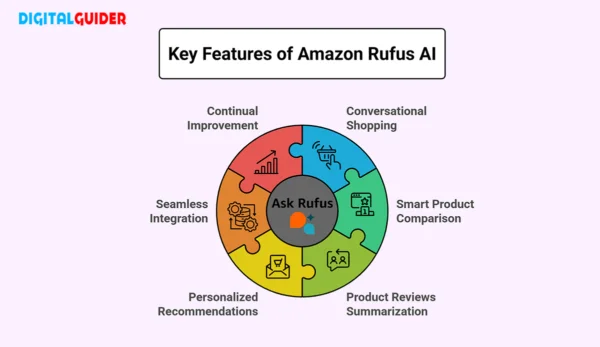
Here’s what makes Rufus stand out:
Conversational Shopping 🗣️
With Amazon AI Rufus, shoppers can simply ask questions (like, “Which wireless earbuds are best for gym workouts?”) and get expert answers instantly. Rufus analyzes each multi-faceted request (like product type, physical needs, price range) and surfaces specific results that a standard search filter might miss.
It understands your intent, responds with tailored suggestions, saves time and effort while maintaining a human-like experience. The product recommendations feel just like voice search optimization in AEO, which processes real questions naturally to recommend ideal products.
Smart Product Comparison ⚖️
Rufus eliminates the need to open dozens of tabs to compare similar items. Using Amazon Rufus AI, you can instantly compare features, ratings, and reviews across multiple products and get a summarized answer of the pros and cons clearly.
Your query might look like:
“Show me a cheaper alternative to this drone that still has a good camera“.
As a result, the AI will generate a clean, side-by-side comparison of key specifications (like megapixels, battery life, and weight) and even incorporates qualitative data (like customer satisfaction) to help you make a final decision without leaving the page.
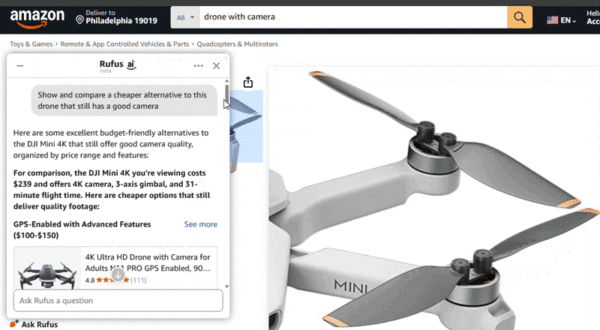
Product Reviews Summarization 💭
Reading through hundreds of customer reviews is a tiring process. That’s why Rufus AI Amazon solves this by analyzing reviews and summarizing the customer opinions into quick highlights. This is a collective “voice of the customer” that includes common praises, complaints, and overall sentiment, showing what buyers loved, what they didn’t, and why, without scrolling endlessly through feedback.
For example, a summary for a specific laptop might read:
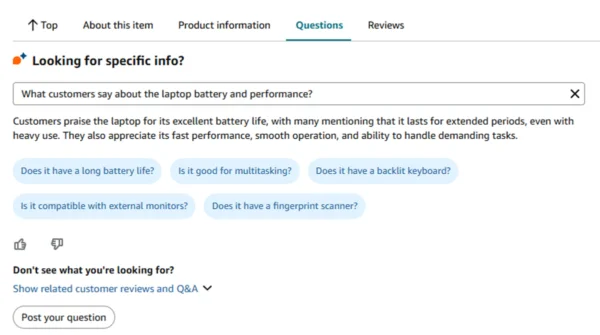
This gives you an honest, crowdsourced appraisal in seconds.
Personalized Recommendations 💡
AI Rufus learns from your browsing and shopping habits. Therefore, it customizes suggestions based on your preferences, search history, and intent, so that you can find exactly what fits your lifestyle. This feature ensures you don’t forget essential companion items and introduces you to products you didn’t know you needed, all while staying relevant to your immediate shopping task.
For example, when you shop for minimalistic home decor, Rufus might highlight matching wall art or lighting options that fit the same aesthetic to help you complete the look.
Seamless Integration with Amazon Shopping 🛒
Rufus is built right into Amazon’s mobile app and website. That means you don’t need to switch screens or install any other app or plugin. You can chat with Rufus, browse and buy, all in one smooth experience, as this blends naturally with your usual shopping flow.
This brings together search, recommendation, and checkout in a seamless AI-powered journey.
Continual Improvement 🧠
The more people interact with Rufus Amazon, the smarter it becomes. It continuously evolves and learns from real shopper queries, feedback, and trends, refines its understanding of what users want, and improves response accuracy over time.
So, what do all these features mean for you as a shopper or a brand?
Let us dive into the real-world benefits of Rufus Amazon AI.
Benefits of Amazon Rufus AI for Shoppers
Amazon Rufus is changing the way people shop online by making the experience effortless and more enjoyable. Here’s how it benefits shoppers:
- Personalized Shopping Experience – As Rufus AI understands natural language & context, it filters results based on shoppers’ preferences, past searches, and behavior. This helps deliver tailored suggestions without endless scrolling.
- Faster Decision Making – By providing instant answers (like comparing products, listing pros and cons, or summarizing reviews), Rufus reduces the time shoppers spend jumping between pages.
- Confidence in Purchases – Rufus on Amazon explains why a product fits a shopper’s need. That additional clarity boosts the brand’s reputation and helps buyers feel confident before clicking “Add to Cart.”
- Conversational Ease – Even first-time users or those unsure about product categories can easily explore through chat-based browsing that makes shopping more natural, inclusive, and fun.
Benefits of Amazon Rufus AI for Sellers & Brands
For sellers and brands, AI Rufus is not just a chatbot, it is an opportunity to grow visibility, trust, and conversions. Here’s why it matters:
- Higher Product Visibility – Rufus understands conversational & context-aware queries (like “What do I need for a rainy day hike?“) that help smaller or niche brands be easily discovered through contextual matches and Amazon SEO strategies, even if the shopper doesn’t use your exact keywords.
- Better Conversion Rates – Since Amazon AI assistant Rufus guides shoppers throughout their buying journey, it helps move users from discovery to purchase faster, leading to higher click-through and conversion rates.
- Improved Customer Insights – Rufus gathers rich conversational data, like what users are asking or comparing, which gives sellers valuable insights to refine their listings, descriptions, and ad strategies.
- Enhanced Brand Credibility – Products featured in Rufus’s AI suggestions automatically gain credibility as the AI filters out irrelevant or low-rated options. This helps emerging brands compete with top names through well-structured content and positive reviews.
- Optimized Ad Performance – With Amazon integrating Rufus insights into its ad system, brands can run more precise and intent-based campaigns to improve ROI on sponsored listings.
To truly benefit from Amazon Rufus, sellers must go beyond traditional SEO and focus on AI-oriented optimization.
How to Optimize Your Amazon Listings for Rufus?
To optimize listings, sellers must speak the same language as Rufus (and the shoppers using it) to stand out in this AI-driven search environment.
1. Think Like a Shopper, Not a Search Engine
Write content that answers real-life questions naturally, as if you were speaking to a customer. Use descriptive, benefit-driven noun phrases instead of basic keywords.
For instance, instead of “Durable backpack,” use “Water-resistant, durable backpack for daily use and travel.” This language focuses on the product’s purpose and how it solves customer problems.
2. Write Descriptive Titles
Your title is the first clue AI Rufus uses to identify what your product is about. So, keep it clear, natural, and keyword-rich (without overstuffing). Mention the brand and the core feature that must be friendly and easily readable for both humans and AI.
For example, imagine you’re listing shoes on Amazon. Instead of stuffing keywords like “Men’s Sports Running Shoes Gym Sneakers,” go for a more natural and readable title like “Lightweight Men’s Running Shoes – Breathable Sneakers for Gym & Daily Use.”

3. Invest in A+ Content & Visuals
Rufus AI Amazon doesn’t “see” images the way humans do, but it identifies signals from content quality and completeness. Therefore, it is essential to utilize high-resolution photos, lifestyle shots, comparison charts, and rich product descriptions to make your listing more appealing.
📌 Pro Tips –
|
4. Leverage Customer Q&A & Reviews
Rufus heavily relies on customer feedback and Q&A to provide its summaries and recommendations. That’s why you should proactively analyze, address, and monitor your customers’ questions & answers and review sections to improve your listing’s visibility and relevance.
Encourage customers to leave detailed reviews that mention specific features and subjective attributes (such as “easy to install” or “perfect fit“). Use these natural terms back into your listing to make it more engaging and search-friendly.
5. Keep Content Updated
Rufus is continually learning and evolving in response to the latest trends, queries, and user interests. So, your listings should evolve with seasonal keywords, images, and new insights to match shoppers’ interests. Staying updated signals active and reliable sellers and keeps your products visible in AI-driven searches.
And here’s a bonus tip most sellers overlook — but it can help you stay one step ahead as Rufus AI continues to evolve.
💡 Bonus Tip – Stay Aware of Rufus Updates & Challenges
As Rufus is still learning, and its algorithms are constantly evolving, it is not flawless yet. The sellers may occasionally notice a slight preference toward Amazon’s own brands in its recommendations. So, stay alert and flexible and keep an eye on how Rufus displays your products, track any changes in visibility, and refine your listing strategy accordingly.
By staying proactive, you can adjust your strategy quickly as the system improves and new optimization patterns emerge.
Once your listings are Rufus-ready, the next big question is – how will this AI change the way Amazon ads work?
How Amazon Rufus Impacts Amazon Advertising?
Amazon AI Rufus is transforming how shoppers search and reshaping how brands advertise on Amazon. As the platform shifts from keyword-based search to conversation-driven discovery, the rules of visibility, targeting, and sponsored listings are evolving fast.
1. Product Discovery Through AI Conversations
In the Rufus era, product discovery begins within natural conversations, not search result pages. When a shopper asks a question, Rufus shows both organic listings and sponsored content to deliver relevant recommendations.
This means your ad performance will depend more on how relevant and context-rich your listing is, not just how much you bid on short or single keywords. Brands that align their ad copy, images, and descriptions with real shopper intent will see better placement.
2. Adaptive Sponsored Listings
Traditional sponsored listings were built around keywords and product categories. But Rufus interprets context and intent and demands semantic optimization, where your listing must reflect natural language terms and customer benefits (such as “eco–friendly,” “light weight”, etc.)
To stay visible, advertisers will need to audit the titles, bullet points, and descriptions that help the AI confidently endorse your product.
3. AI-Driven Relevance over High Bids
In Rufus, ad visibility is not just a bidding game anymore. Amazon’s algorithm prioritizes ads’ contextual and semantic relevance over high bids.
The ads must perfectly match what shoppers are looking for in chat.
This means that advertisers should invest in richer copy, better visuals, and stronger review signals that could deliver higher ROI than simply increasing your PPC budget.
4. Data Insights & Intent-Based Targeting
Rufus on Amazon opens the door to a goldmine of new data. Every chat interaction captures rich intent signals about what users ask, compare, and prioritize. Amazon could feed these insights into advertising dashboards, helping brands understand what customers mean rather than what they type.
This is a huge opportunity for marketers to refine keyword strategies, improve audience segmentation, and create ads that align with evolving buyer behavior.
TL;DR – From Search Bar to Smart Chat
Amazon Rufus AI marks the beginning of a smarter, intent-driven era for both shoppers and advertisers. As AI is turning every search into a natural conversation, it bridges the gap between curiosity and conversion. Shoppers get faster, smarter, and more relevant results, while sellers gain deeper insights into what customers truly want.
It is a great opportunity for brands to optimize their product listings, visuals, and ad strategies around how shoppers talk (not just search). This is the key to staying visible and competitive. This is the future of eCommerce on Amazon that is more about understanding intent, creating value, and connecting through context.
Empower your Amazon presence for the conversational era and partner with Digital Guider today.
FAQs – Amazon Rufus AI
Q1. How is Amazon Rufus different from Alexa or ChatGPT?
A1. Unlike Alexa or ChatGPT, which are general-purpose assistants, Rufus is built specifically for shopping and helps shoppers make purchase decisions directly on Amazon.
Q2.Can Rufus actually predict what I want to buy next?
A2. Yes! Rufus analyzes your shopping patterns, previous searches, and browsing behavior to recommend products you are likely to need.
Q3.How does Rufus handle product comparisons?
A3. Rufus AI simplifies decisions by summarizing key differences (such as features, ratings, or prices), explaining them, and helping shoppers compare more quickly.
Q4. Can Rufus replace the need for manual filters (price, size, color)?
A4. Mostly yes, you can just say your preferences instead of clicking multiple filters.
Q5. Can Rufus help me discover new brands I’ve never heard of?
A5. Yes! AI Rufus suggests relevant but lesser-known brands that fit your needs and price range.
Q6. Does Rufus suggest deals or discounts?
A6. Yes, it highlights active offers, coupons, and lightning deals relevant to your search.
Q7. Can Amazon Rufus AI help reduce product return rates?
A7. Potentially, yes. Since Rufus provides more accurate recommendations based on intent and context, shoppers are more likely to buy what truly fits their needs, resulting in fewer returns.
Q8. How will Rufus impact small sellers compared to big brands?
A8. Rufus AI Amazon aims to prioritize context and relevance over ad spend. Small sellers with well-optimized listings can now compete with larger brands in AI-driven recommendations.
Q9. Does Amazon Rufus collect my personal data?
A9. Rufus uses the same Amazon account data you already share (like browsing and purchase history) to personalize results, not to collect new personal information.
Q10. What happens if I clear my Amazon history? Will Rufus still know me?
A10. Once you delete your browsing and shopping history, Rufus resets your personalized recommendations too.



